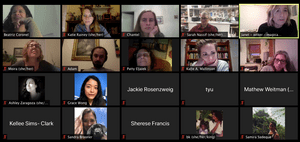Sometimes when clichés become tired enough, it is time to flip them on their heads. I remember Tim Parks doing so in an article for The New York Review titled “Gained in Translation”—the mere reversal of a worn-out phrase nuancing my entire understanding of an under-appreciated practice. Like Parks, what is lost in translation does not interest me. Rather, I am interested in translators who “bring more to the work, and not less.”


On Thursday, schools once again closed in New York City, and students returned to the virtual classroom. Though the health and safety of students, teachers, and staff is of the utmost importance, the fact that schools were opened at all during the COVID-19 pandemic seems to signal our underlying desire for normalcy. The closure of schools seems as far reaching and multifaceted as the epidemic itself—the added strain to working parents, the anxiety of public educators and school staff losing what were once secure jobs, the real possibility of becoming ill and/or contagious without access to affordable healthcare—leading to numerous headlines about the bleak outlook on the future of education.
As both a student and educator, I can say unequivocally that the in-person classroom experience is (unsurprisingly) more effective than the virtual. Zoom is fatiguing, distracting, and awkward—an onslaught of new challenges has left students and educators with mutual distain for the online classroom. When online classes first began, teachers could not help but attempt to translate the in-person experience to the screen—how else could we continue our lessons? Not only were we (students and teachers) underprepared for this dramatic pivot midway through the spring semester, but online teaching requires almost an entirely new set of skills. Our inability to translate the in-person experience to the virtual inevitably led to comparisons, which left us yearning for the life we once knew. But perhaps the underlying problem is not that we constantly outweigh the positives of virtual classrooms (and yes, there are some) with the negatives, but that we have never once asked what can be gained from Zoom when it is time to return to school.
Creating a classroom environment where students feel comfortable enough to express their thoughts and opinions, engage with challenging material, and feel both empowered and inspired is the goal of every teacher. It is always frustrating to know that the students reticent to speak have as much to offer to the discussion as the more extroverted ones. How do we encourage these students to speak up without making them uncomfortable and/or discouraging those that are more willing to speak? Strangely enough, I have found that the virtual classroom has offered me a new option of tackling this problem. By breaking up the large group into smaller and randomized Break-Out Rooms, reticent students are much less intimidated to speak. After twenty or so minutes discussing a text in their small groups, we reconvene and discuss our discussions as short panel presentations. The effects of this have been remarkably encouraging. Not only does this lead full participation in organic and lively discussion, but students are much more supportive one another. For example, I have seen this situation pan out: Ashley (our introverted student) is paired with Peter (our extrovert) and Christine (who falls somewhere in the middle). “Ashley actually brought up X, which I had never considered…” says Peter; and Ashley, feeling fully supported by her peers, begins to elaborate/clarify X. Though this small group discussion may be familiar to many educators, I have found that in the virtual Break Out Room, where students cannot overhear or see the discussions of other groups, it is much more effective.


Similarly, I have found the Chat Box an important tool. I relate to those students who do not always feel comfortable speaking outright, but rather gathering their thoughts in text. I have encouraged a secondary discussion in this window, thus, what would otherwise be a distraction becomes a focused and relevant tool in the virtual classroom. As these techniques have been quite successful, I have begun to wonder if there will be ways to incorporate them in the in-person classroom when the time comes. When we work with our constraints, and not against them, the possibility to transcend the virtual barriers is actualized.



